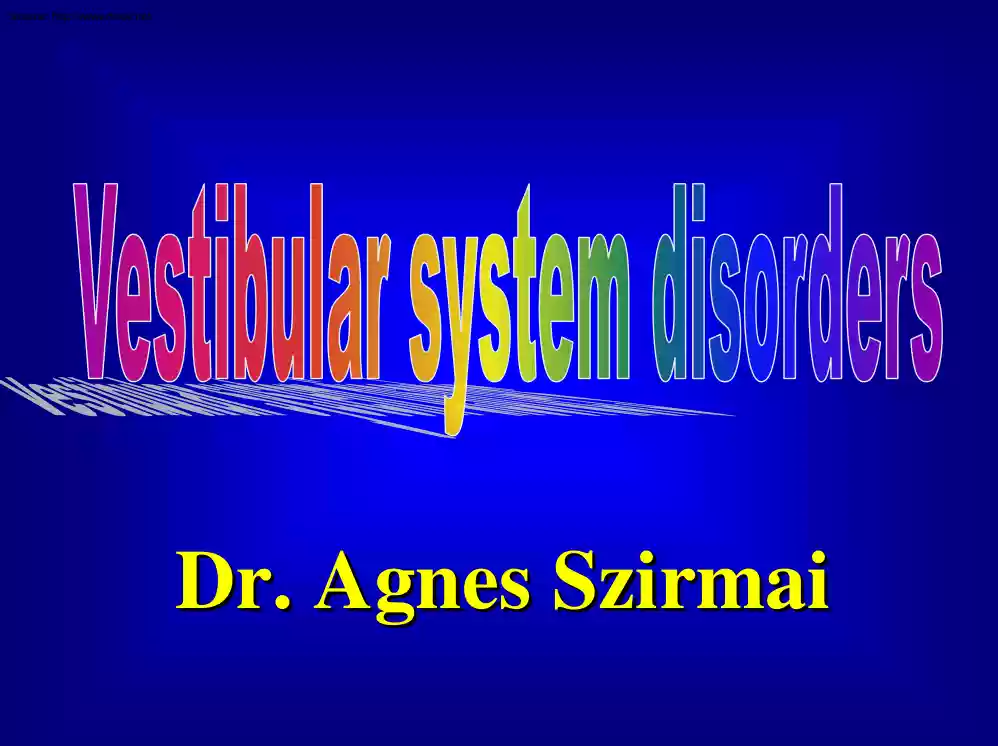Comments
No comments yet. You can be the first!
Content extract
Source: http://www.doksinet Dr. Agnes Szirmai Source: http://www.doksinet Source: http://www.doksinet Source: http://www.doksinet Labyrinth Vestibular nerve Vestibular nuclei Vestibular pathways (vestibulocerebellar, vestibulospinal, vestibuloocular, vestibuloreticular) Source: http://www.doksinet Space orientation Proprioceptive afferentation Brainstem nuclei and pathways Visual field control Visual afferentation Vestibular afferentation Muscle tone control Source: http://www.doksinet ORL Psychiatry Rheumatology Neurology Vertigo Family care Ophthalmology Internal medicine Source: http://www.doksinet Case history Nystagmus Vestibulospinal function (Romberg- test, blind walking test) Provoked nystagmus (special tests) Source: http://www.doksinet Previous vertigo-provoking diseases: heart diseases, blood-pressure, renal failures, drugs, ear diseases, neurological diseases, neck vertebra problems Types of vertigo: rotatory vertigo, unsteadiness,
lightheadedness, imbalance Length of vertigo : seconds, minutes, hours, days, constant dizziness Single ⇔recurrent attacks Concomitant symptoms: hearing loss, tinnitus, discharge from ear, nausea, vomits, loss of consciousness, headache Source: http://www.doksinet Differential diagnostic value Length of vertigo Disease Seconds Benign positional paroxysmal vertigo Minutes Labyrinthine fistula Hours Meniére’s disease Days Vestibular neuronitis, herpes zoster, labyrinthitis Constant vertigo Pyramid bone fracture, Vestibular schwannoma Source: http://www.doksinet DIFFERENTIAL DIAGNOSTIC VALUE Hearing loss is obligatory: Conductive: labyrinthitis Sensorineural: Cochlear lesion: Meniere’s disease, labyrinthine artery occlusion, Retrocochlear lesion: vestibular schwannoma No hearing loss: Vestibular neuronitis , benign paroxysmal positional vertigo Hearing loss is optional: pyramid bone fracture, herpes zoster Source: http://www.doksinet Case
history Nystagmus Vestibulospinal function (Rombergtest, blind walking test) Provoked nystagmus (special tests) Source: http://www.doksinet Non-voluntary, rhythmical eye movement Slow and quick phase. I. degree: looking to nystagmus direction II. degree: looking forward III.degree: looking oppositely to nystagmus direction Source: http://www.doksinet Case history Nystagmus Vestibulospinal function (Rombergtest, blind walking test ) Provoked nystagmus (special tests) Source: http://www.doksinet Romberg’s test Past pointing tests Blind walking test Source: http://www.doksinet Case history Nystagmus Vestibulospinal function Provoked nystagmus (special tests) Source: http://www.doksinet Harmonic syndrome-peripheral lesion Direction of tilting , deviation and past-pointing is opposite to the nystagmus direction Disharmonic syndrome- central dysfunction Direction of tilting and deviation is the same, as the main direction of
nystagmus Source: http://www.doksinet Pyramid bone fracture Infections: Vestibular neuronitis Herpes zoster oticus Labyrinthitis Vascular lesion:Sudden loss of hearing and balance Tumours: Vestibular schwannoma Others: Meniére’s disease Benign paroxysmal positional vertigo Traumas: Source: http://www.doksinet Longitudinal or transversal fracture Cochlear damage: sensorineural hearing loss Semicircular canal damage:vertigo VIII. nerve damage:hearing loss and vertigo VII. nerve damage: facial palsy Additional symptoms: headache, cerebrospinal fluid leakage Source: http://www.doksinet Sudden loss of peripheral vestibular function, caused by viral infection Symptoms: Sudden onset, severe , few-days long rotatory vertigo with loss of balance Vomitus, nausea Normal hearing After the acute phase: constant unsteadiness (complete recovery: 2-3 months) Source: http://www.doksinet Herpes eruptions in the auricle Sensorineural hearing loss Vertigo
Facial palsy Source: http://www.doksinet Middle ear cholesteatoma propagates to inner ear Source: http://www.doksinet Complication of chronic middle ear infection Circumscript labyrinthitis: fistula-symptom Serous labyrinthitis: excitation of labyrinth (nystagmus to the affected side, severe combined hearing loss) Purulent labyrinthitis: loss of inner ear function ( total deafness, nystagmus to the healthy side) Treatment: surgery- radical mastoidectomy Source: http://www.doksinet Sudden deafness Severe tinnitus Severe vertigo Occlusion of labyrinthine artery Source: http://www.doksinet Slowly growing benign tumour in internal auditory canal or in cerebellopontine angle Symptoms: Unilateral hearing loss and tinnitus Unsteadiness (slow loss of function) Facial numbness Facial palsy Source: http://www.doksinet Synonym: acoustic neuroma Treatment: surgery Source: http://www.doksinet Few hours long attacks with: rotatory vertigo and nystagmus
nausea and vomitus unilateral hearing loss unilateral tinnitus Source: http://www.doksinet Source: http://www.doksinet Source: http://www.doksinet Source: http://www.doksinet statoconia detach A from membrane insufficient lysis in endolymphe sink into canal clod together Benign paroxysmal positional vertigo 30 seconds-long attacks gravity Fatiguable rotatory nystagmus Source: http://www.doksinet Source: http://www.doksinet
lightheadedness, imbalance Length of vertigo : seconds, minutes, hours, days, constant dizziness Single ⇔recurrent attacks Concomitant symptoms: hearing loss, tinnitus, discharge from ear, nausea, vomits, loss of consciousness, headache Source: http://www.doksinet Differential diagnostic value Length of vertigo Disease Seconds Benign positional paroxysmal vertigo Minutes Labyrinthine fistula Hours Meniére’s disease Days Vestibular neuronitis, herpes zoster, labyrinthitis Constant vertigo Pyramid bone fracture, Vestibular schwannoma Source: http://www.doksinet DIFFERENTIAL DIAGNOSTIC VALUE Hearing loss is obligatory: Conductive: labyrinthitis Sensorineural: Cochlear lesion: Meniere’s disease, labyrinthine artery occlusion, Retrocochlear lesion: vestibular schwannoma No hearing loss: Vestibular neuronitis , benign paroxysmal positional vertigo Hearing loss is optional: pyramid bone fracture, herpes zoster Source: http://www.doksinet Case
history Nystagmus Vestibulospinal function (Rombergtest, blind walking test) Provoked nystagmus (special tests) Source: http://www.doksinet Non-voluntary, rhythmical eye movement Slow and quick phase. I. degree: looking to nystagmus direction II. degree: looking forward III.degree: looking oppositely to nystagmus direction Source: http://www.doksinet Case history Nystagmus Vestibulospinal function (Rombergtest, blind walking test ) Provoked nystagmus (special tests) Source: http://www.doksinet Romberg’s test Past pointing tests Blind walking test Source: http://www.doksinet Case history Nystagmus Vestibulospinal function Provoked nystagmus (special tests) Source: http://www.doksinet Harmonic syndrome-peripheral lesion Direction of tilting , deviation and past-pointing is opposite to the nystagmus direction Disharmonic syndrome- central dysfunction Direction of tilting and deviation is the same, as the main direction of
nystagmus Source: http://www.doksinet Pyramid bone fracture Infections: Vestibular neuronitis Herpes zoster oticus Labyrinthitis Vascular lesion:Sudden loss of hearing and balance Tumours: Vestibular schwannoma Others: Meniére’s disease Benign paroxysmal positional vertigo Traumas: Source: http://www.doksinet Longitudinal or transversal fracture Cochlear damage: sensorineural hearing loss Semicircular canal damage:vertigo VIII. nerve damage:hearing loss and vertigo VII. nerve damage: facial palsy Additional symptoms: headache, cerebrospinal fluid leakage Source: http://www.doksinet Sudden loss of peripheral vestibular function, caused by viral infection Symptoms: Sudden onset, severe , few-days long rotatory vertigo with loss of balance Vomitus, nausea Normal hearing After the acute phase: constant unsteadiness (complete recovery: 2-3 months) Source: http://www.doksinet Herpes eruptions in the auricle Sensorineural hearing loss Vertigo
Facial palsy Source: http://www.doksinet Middle ear cholesteatoma propagates to inner ear Source: http://www.doksinet Complication of chronic middle ear infection Circumscript labyrinthitis: fistula-symptom Serous labyrinthitis: excitation of labyrinth (nystagmus to the affected side, severe combined hearing loss) Purulent labyrinthitis: loss of inner ear function ( total deafness, nystagmus to the healthy side) Treatment: surgery- radical mastoidectomy Source: http://www.doksinet Sudden deafness Severe tinnitus Severe vertigo Occlusion of labyrinthine artery Source: http://www.doksinet Slowly growing benign tumour in internal auditory canal or in cerebellopontine angle Symptoms: Unilateral hearing loss and tinnitus Unsteadiness (slow loss of function) Facial numbness Facial palsy Source: http://www.doksinet Synonym: acoustic neuroma Treatment: surgery Source: http://www.doksinet Few hours long attacks with: rotatory vertigo and nystagmus
nausea and vomitus unilateral hearing loss unilateral tinnitus Source: http://www.doksinet Source: http://www.doksinet Source: http://www.doksinet Source: http://www.doksinet statoconia detach A from membrane insufficient lysis in endolymphe sink into canal clod together Benign paroxysmal positional vertigo 30 seconds-long attacks gravity Fatiguable rotatory nystagmus Source: http://www.doksinet Source: http://www.doksinet





 Just like you draw up a plan when you’re going to war, building a house, or even going on vacation, you need to draw up a plan for your business. This tutorial will help you to clearly see where you are and make it possible to understand where you’re going.
Just like you draw up a plan when you’re going to war, building a house, or even going on vacation, you need to draw up a plan for your business. This tutorial will help you to clearly see where you are and make it possible to understand where you’re going.